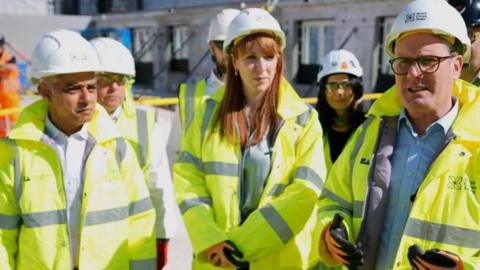The government has outlined plans to tackle England's housing shortage, with local councils given targets for new homes in their area.
Housing Minister Matthew Pennycook said the focus is on areas where housing is least affordable.

The government has outlined plans to tackle England's housing shortage, with local councils given targets for new homes in their area.
Housing Minister Matthew Pennycook said the focus is on areas where housing is least affordable.
The aim is for 370,000 new homes in England every year, to fulfil a government promise for 1.5m new homes within the next five years.
Local authorities are being told to give developers permission to build.
Millions of people can't afford to buy their first home and there is a backlog of people living in unsuitable accommodation.
According to the government, 1.3 million households are on social housing waiting lists and a record number – including 160,000 children – are in temporary accommodation.
The government, which announced its plans in the updated National Planning Policy Framework, has not set a date for when the 370,000 target will be reached.
Areas with the most unaffordable housing but the greatest potential for growth have the highest housebuilding targets, the government said.
Pennycook told the Commons the government will be "focusing growth on city regions".
Cities facing an increase include St Albans, where the target is rising from 885 under the previous Conservative government to 1,660. In Oxford, the target is rising from 762 to 1,087.
The South East as a whole will have an annual quota of almost 71,000 - an increase of about 20,000.
London will see its annual quota as a whole set to around 88,000. That's around 10,000 less than the target under the previous Conservative government.
However, there are variations within the capital, with some areas being given higher targets. For example, Kensington and Chelsea is being asked to build 5,107 new homes - up from 1,381. The target for Westminster is 4,341 - up from 1,862.
Other notable changes include:
Previously developed land will be prioritised for new homes, the government said. These "brownfield sites" can include places like derelict industrial or commercial developments.
However, Pennycook said brownfield land alone will not be enough to deliver the number of homes the country needs.
As a result, councils will also be ordered to review green belt boundaries - which were created to prevent urban sprawl - by identifying lower quality "grey belt" land that can be built on.
The government has previously described the grey belt as "poor quality and ugly areas" on the green belt. A disused garage in Tottenham, north London, which could not be built on because it was within the green belt, has been used as an example.
There is no official data on the size of the grey belt.
However, estate agent Knight Frank carried out research and identified 11,000 previously developed sites – making up less than 1% of the green belt.
These were concentrated in the south of England, with just over 40% within the London green belt area.
They estimated that 100,000-200,000 new family homes could be built on grey belt sites.
The prime minister said development would be locally led, with the land developed "brownfield first, grey site next, and greenbelt last".
Conservative shadow housing secretary Kevin Hollinrake said: "This planning framework pushes development to rural areas, concreting over green belt, green fields and over our green and pleasant land."
Announcing its plans, the government said councils and developers must give greater consideration to social rent when building new homes.
It said local leaders will have "greater powers to build genuinely affordable homes for those who need them most".
The definition of affordable homes includes homes for sale as part of a shared-ownership scheme, or those rented at a lower rate, or as part of a social housing agreement.
Any development on green belt must meet strict requirements, with developers having to provide infrastructure for local communities, such as nurseries, GP surgeries and transport, the government said.
There are just under 700,000 empty and unfurnished homes in England, according to the most recent government figures.
Of those, 261,471 are classed as "long-term empty," meaning no-one has lived there for six months or more.
But bringing derelict and abandoned properties back to life can be a long and complex process.
Even finding out who owns properties that have been standing empty for years, or in some cases decades, can be a challenge.